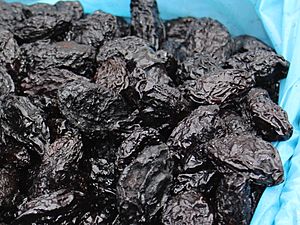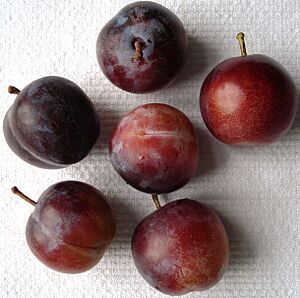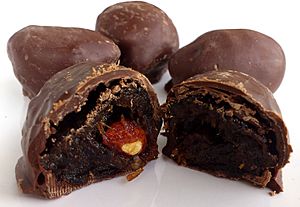Prune facts for kids
| Nutritional value per 100 g (3.5 oz) | |
|---|---|
| Energy | 1,006 kJ (240 kcal) |
|
63.88 g
|
|
| Sugars | 38.13 g |
| Dietary fiber | 7.1 g |
|
0.38 g
|
|
|
Protein
|
2.18 g
|
| Vitamins | Quantity
%DV†
|
| Vitamin A equiv.
beta-Carotene
lutein zeaxanthin
|
5%
39 μg
4%
394 μg148 μg
|
| Thiamine (B1) |
4%
0.051 mg |
| Riboflavin (B2) |
16%
0.186 mg |
| Niacin (B3) |
12%
1.882 mg |
| Pantothenic acid (B5) |
8%
0.422 mg |
| Vitamin B6 |
16%
0.205 mg |
| Folate (B9) |
1%
4 μg |
| Choline |
2%
10.1 mg |
| Vitamin C |
1%
0.6 mg |
| Vitamin E |
3%
0.43 mg |
| Vitamin K |
57%
59.5 μg |
| Minerals | Quantity
%DV†
|
| Calcium |
4%
43 mg |
| Iron |
7%
0.93 mg |
| Magnesium |
12%
41 mg |
| Manganese |
14%
0.299 mg |
| Phosphorus |
10%
69 mg |
| Potassium |
24%
732 mg |
| Sodium |
0%
2 mg |
| Zinc |
5%
0.44 mg |
| Other constituents | Quantity |
| Water | 31 g |
|
Link to USDA Database entry
|
|
| †Percentages estimated using US recommendations for adults. | |
A prune is simply a dried plum. Most prunes come from a type of plum called the European plum (Prunus domestica).
When you eat a prune, the seed (or pit) inside is usually easy to remove. These are called freestone plums. Most fresh plums, however, are clingstone, meaning their pits are harder to get out.
Prunes are full of good things for your body. They have lots of carbohydrates and dietary fiber. They are also a great source of vitamin K. Prunes can help keep your digestive system working well.
Contents
Growing Prunes
More than 1,000 different types of plums are grown to be dried into prunes. In the United States, a popular type is called the 'Improved French' prune. Other types include 'Sutter', 'Tulare Giant', and 'Imperial'.
Fresh prunes often appear in stores earlier than other fresh plums. They are usually smaller in size too.
Why the Name Change?
In 2001, plum growers in the United States got permission to call prunes "dried plums." This change happened because some people thought the word "prune" sounded old-fashioned. Also, prunes are well-known for helping with constipation, and some companies wanted to avoid that connection on their packaging. So, you might see "dried plums" on labels instead of "prunes."
Prunes and Your Health
Prunes contain dietary fiber, which is good for your digestion. This fiber, along with a natural sugar alcohol called sorbitol, helps your body digest food. Eating about 100 grams (a little less than half a cup) of prunes each day can help keep your digestive system regular.
What's Inside Prunes?
Prunes are about 31% water and 64% carbohydrates. About 7% of their weight is dietary fiber. They also have 2% protein and very little fat.
Prunes are an excellent source of vitamin K. They also provide good amounts of several B vitamins and other important dietary minerals.
Natural Plant Compounds
Prunes and prune juice contain special plant compounds called phytochemicals. These include things like phenolic compounds and sorbitol. These compounds are part of what makes prunes healthy.
How Prunes Are Used
Prunes are used in many different kinds of dishes. You can find them in both sweet desserts and savory meals.
It's interesting to know that "sugar plums" are not actually made from boiled plums or prunes. Instead, sugar plums are usually nuts, seeds, or spices covered in a hard sugar coating. They are also known as comfits.
Images for kids
-
Raw, fresh prune plums that have not been dried into prunes
See also
 In Spanish: Ciruela pasa para niños
In Spanish: Ciruela pasa para niños





